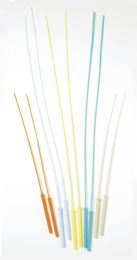

























.jpg&newheight=260&quality=80)


What is a feeding tube?
A feeding tube is a tube made of silicone or polyurethane that directly delivers nutrition to the GI tracts of patients who are unable to eat regular food due to medical conditions that put them at risk for choking or aspiration, or who can’t or won’t eat on their own due to neurological or psychological issues. The tubes come in a variety of diameters measured in French units, or increments of a third of a centimeter. The diameter of the tube used depends on its placement, intended duration of use, and the patient’s age and medical issues.
When are feeding tubes used?
Feeding tubes are employed when patients aren’t able to eat enough on their own to meet their individual daily requirements for calories, fats, carbohydrates, proteins, fiber and micronutrients such as vitamins and minerals to heal from illness, injury, or surgery or for general good health. The tube may be the primary source of nutrition, or provide supplemental feeding. Even when a tube is in use, a patient may still be able to drink fluids such as water, tea, or coffee if they are mixed with a thickening agent to facilitate swallowing.
How do feeding tubes work?
There are two methods for tube feeding. The use of a nasogastric, or NG tube, involves introducing the tube into the GI tract through the patient’s nostril, down the esophagus, and into the stomach or the small intestine. The NG tube is intended for short term use, such as recovery from an injury or illness. In some instances, the tube may be introduced into the GI tract through the mouth.
For long term use due to chronic conditions, the tube is introduced through a small, surgically created opening in the abdominal wall called a gastrostomy. The patient is sedated and a local anesthetic is administered to the abdomen. With the help of an endoscope or imaging equipment, the surgeon makes an incision and then inserts the tube directly into the stomach or small intestine. A holder called a “button” to keep the tube in place may be implanted at this time as well.
Before feeding, the patient is placed in an upright position, either seated in a chair or by raising the bed to allow the formula to enter the GI tract as similarly as possible to the act of eating regular food, as well as helping to prevent gas formation and possible vomiting. A syringe or bag filled with a formula to meet the patient’s individual needs for calories, fiber, fat, vitamins and micronutrients as ordered by a registered dietitian is attached to the free end of the tube.
The formula is introduced slowly and steadily by one of three methods: pushing down on the syringe’s plunger, a gravitational feed created by hanging the bag several feet above the patient, or in some cases by using a small mechanical pump for precise control. Control of the flow of formula is especially important in situations where the patient is sensitive to the volume of the incoming formula, may be at risk for aspiration, is being fed in the small intestine or has delayed gastric emptying.
After the feeding, the tube is flushed with water in order to keep the patient properly hydrated and to prevent clogs. Feedings may be at scheduled times or may be continuous depending on the patient’s needs.
Who benefits from feeding tubes?
Two categories of patients may benefit from feeding tubes. The first are pediatric and adult patients who have normal gastrointestinal function but are comatose, require a ventilator or a respirator to breathe, or have difficulty swallowing due to injuries or surgery to the upper GI tract or throat. Feeding tubes may be indicated for neurological conditions such as ALS or the aftereffects of a stroke, for patients with cancer impacting the neck, head and throat or undergoing treatment for it that makes swallowing painful or impossible, for patients who are at risk for choking or developing pneumonia due to aspiration of food or liquids, or those who won’t or can’t eat enough on their own to meet their nutritional needs, such as patients with advanced dementias or eating disorders like anorexia. Premature infants or small children who fail to thrive by eating on their own may be candidates for feeding tubes as well.
The second category are patients living with lower GI conditions such as short bowel syndrome, Crohn’s disease, gastroparesis, genetic disease such as Sanfillipo’s syndrome, or bowel obstruction which may interfere with the body’s ability to absorb nutrients from regular food through the intestinal tract.
Whether used as a primary or supplemental method of nutrition delivery, feeding tubes are appropriate for use both in healthcare facilities such as hospitals and nursing homes as well as private residences under supervision by visiting home healthcare professionals and with directions from the patient’s physician and dietician.
Rehabmart is proud to carry supplies from esteemed vendors that include McKesson Medical Surgical and Independence Medical and other fine vendors.
Hulet Smith, OT
Rehabmart Co-Founder & CEO
fj